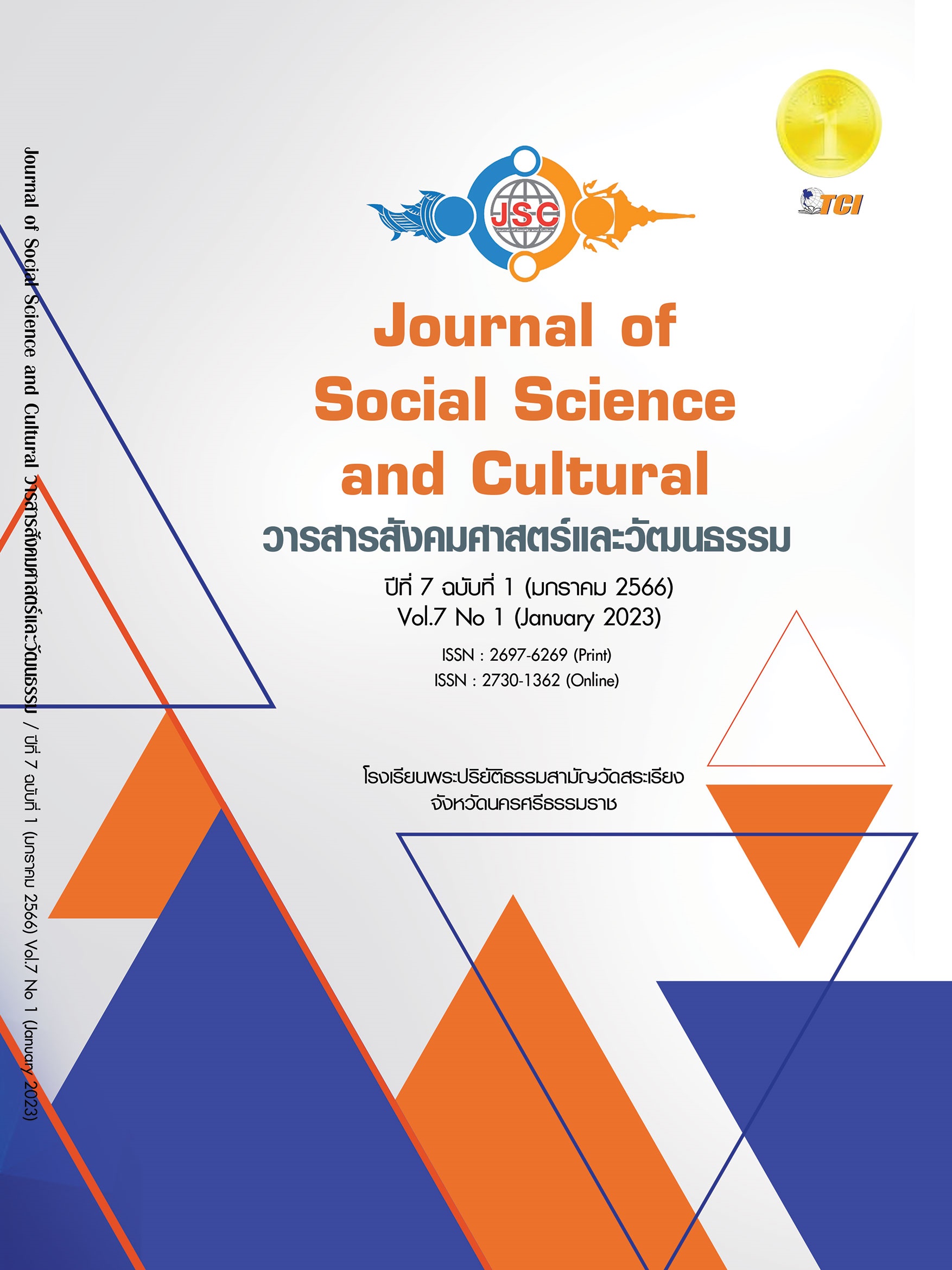THE INFLUENCE OF CAUSAL FACTORS OF TEACHERS' ORGANIZATIONAL COMMITMENT IN THE THREE SOUTHERN BORDER PROVINCES
Main Article Content
Abstract
The article had two objectives: 1) to develop and investigate the congruence of the causal influence model on the organizational commitment of the teachers in the three southern border provinces and 2) to study the factors of the causal influence model on the organizational commitment of the teachers in the three southern border provinces. The research was quantitative. The population was 10,943 government teachers and the sample group was 557 government teachers from the multi-stage sampling method. The questionnaires for collecting data consisted of two parts: the first part was the general information of an informant, and the second part was the information about the factors that influence organizational commitment. The second part included four sections: 1) the organizational commitment questionnaire, 2) the organizational climate questionnaire, 3) the quality of working life questionnaire, and 4) the organizational culture questionnaire. The whole questionnaire had a reliability equal to 0.98. The data were analyzed by descriptive statistics to find frequency and percentage and inferential statistics to analyze the relationship with structural equation modeling (SEM) through an instant program. The results indicated that the causal influence model on the organizational commitment of the teachers in the three southern border provinces consisted of four latent variables: organizational commitment, organizational climate, quality of working life, and organizational culture. Also, the model was nicely consistent with the data by considering = 179.20, df = 153, p = 0.07, RMSEA = 0.02, RMR = 0.01, GFI = 0.97, AGFI = 0.96. The coefficient of forecasting was 0.78, so those latent variables in the model could interpret the variance of the organizational commitment to be 78 percent. In addition to the causal factors, the organizational climate factor had the most direct influence on the organizational commitment, and the organizational culture factor had the most indirect influence on the organizational commitment.
Article Details
References
จินตศักดิ์ ยุชัยสิทธิกุล. (2559). ความสัมพันธ์ระหว่างวัฒนธรรมองค์การกับบรรยากาศองค์การ ของ โรงเรียนคาทอลิก สังกัดอัครสังฆมณฑลกรุงเทพมหานคร. ใน วิทยานิพนธ์ครุศาสตรมหาบัณฑิต สาขาวิชาการบริหารการศึกษา. มหาวิทยาลัยราชภัฏธนบุรี.
จิระวัฒน์ ตันสกุล. (2558). การพัฒนาโมเดลการวัดและโมเดลสมการเชิงโครงสร้างพหุระดับความผูกพันของครู. ใน ดุษฎีนิพนธ์ครุศาสตรดุษฎีบัณฑิต สาขาวิชาการวัดและประเมินผลการศึกษา. จุฬาลงกรณ์มหาวิทยาลัย.
ชุติมา สุทธิประภา และคณะ. (2561). บรรยากาศองค์การ และความยึดมั่นผูกพันต่อองค์การของพยาบาลวิชาชีพ โรงพยาบาลในเครือเอกชนแห่งหนึ่ง. วารสารพยาบาล, 67(4), 25-33.
ฐนิชา คงประดิษฐ์ และปรีชา คำมาดี. (2563). การบริหารทรัพยากรมนุษย์เพื่อขับเคลื่อน เศรษฐกิจในยุคไทยแลนด์ 4.0. วารสารบัณฑิตศึกษามหาจุฬาขอนแก่น, 7(3), 45- 60.
ธานินทร์ ศิลป์จารุ. (2560). การวิจัยและวิเคราะห์ข้อมูลทางสถิติด้วย SPSS และ AMOS. (พิมพ์ครั้งที่ 17). กรุงเทพมหานคร: บิสซิเนสอาร์แอนด์ดี.
นริศรา จินดาพันธ์ และอัมพร ศรีประเสริฐสุข. (2559). การศึกษาความผูกพันที่มีต่อองค์การของครูที่ปฏิบัติงานในโรงเรียนลำปางกัลยาณี อำเภอเมือง จังหวัดลำปาง. วารสารครุศาสตร์ปริทรรศน์, 3(1), 35-42.
บุญโรม สุวรรณพาหุ. (2557). ผลของกลุ่มการปรึกษาเชิงจิตวิทยาแนวความหมายในชีวิตต่อการเปลี่ยนแปลงของสุขภาวะในเยาวชนผู้กระทำผิดที่ใช้สารเสพติดที่มีระดับการควบคุมตนเองแตกต่างกัน. ใน ดุษฎีนิพนธ์ศิลปศาสตรดุษฎีบัณฑิต สาขาวิชาจิตวิทยา. จุฬาลงกรณ์มหาวิทยาลัย.
ลาวัลย์ เกติมา. (2561). การขับเคลื่อนกลยุทธ์การบริหารทรัพยากรบุคคลของโรงเรียนพบพระวิทยาคม สังกัดสำนักงานเขตพื้นที่การศึกษามัธยมศึกษา เขต 8. วารสารการศึกษาศาสตร์, 19(1), 174-192.
สถาบันพัฒนาครูและบุคลากรทางการศึกษาชายแดนใต้. (2561). สถิติเปรียบเทียบจำนวนโรงเรียน ครูและนักเรียนของแต่ละสังกัด ปี 2560. เรียกใช้เมื่อ 23 มกราคม 2565 จาก https://pts.yru.ac.th/school-gis/gis/s_1.php
สายหยุด อมรลักษณ์ปรีชา. (2560). ปัจจัยที่ส่งผลต่อความผูกพันในองค์การของพยาบาลวิชาชีพที่ปฏิบัติงานในโรงพยาบาลบ้านแพ้ว. ใน วิทยานิพนธ์ศิลปศาสตรมหาบัณฑิต สาขาวิชาการจัดการภาครัฐและภาคเอกชน. มหาวิทยาลัยศิลปากร.
สำนักงานคณะกรรมการการศึกษาขั้นพื้นฐาน. (2564). ระบบสารสนเทศเพื่อการบริหารการศึกษา. เรียกใช้เมื่อ 15 พฤศจิกายน 2564 จาก https://data.bopp-obec. info/emis/
สุดารัตน์ พิมลรัตนกานต์ และวิโรจน์ เจษฎาลักษณ์. (2560). การรับรู้บรรยากาศองค์การ ความพึงพอใจในงานความผูกพันต่อองค์การ การปฏิบัติงานตามบทบาทหน้าที่. Veridian E Journal, 10(2), 1611-1629.
สุนิสา เนาวรัตน์. (2563). ปัจจัยที่ส่งผลต่อบรรยากาศองค์การของโรงเรียนสังกัดสำนักงานเขตพื้นที่การศึกษามัธยมศึกษา เขต 2. ใน วิทยานิพนธ์การศึกษามหาบัณฑิต สาขาวิชาการบริหารการศึกษา. มหาวิทยาลัยบูรพา.
สุภมาส อังศุโชติ และคณะ. (2557). สถิติวิเคราะห์สำหรับการวิจัยทางสังคมศาสตร์และพฤติกรรมศาสตร์:เทคนิคการใช้โปรแกรมLISREL . (พิมพ์ครั้งที่ 4). กรุงเทพมหานคร: เจริญดีมั่นคงการพิมพ์.
อนุดิษฐ์ ฐานไชยกร. (2562). ความผูกพันในองค์การ. Journal of Roi Kaensarn Academi, 4(1), 33-46.
อภิรัฐ บุญศิริ. (2559). วิถีชีวิตของครอบครัวกับผลกระทบจากเหตุการณ์ความไม่สงบชายแดนใต้ : กรณีศึกษาเขตพื้นที่พัฒนาพิเศษเฉพาะกิจชายแดนใต้จังหวัดสงขลาตั้งแต่ พ.ศ. 2547-พ.ศ.2557. วารสารมนุษยศาสตร์สังคมศาสตร์ มหาวิทยาลัยทักษิณ, 11(1), 237-254.
Allen, N. & Meyer, J. (1997). Commitment in the workplace: Theory research and application. Thousand Oaks, California: Sage.
Cook, R. A., & Lafferty, L. J. (1989). Organization culture inventory. Plymouth, MI: Human Syner-gistics.
David, J. (1998). Organizational Behavior: The Management of Individual and Organization Performance. (2nd ed.). Boston: Allyn and Bacon.
Dunham, R. B., et al. (1994). Organizational commitment: The utility of an integrative definition. Journal of Applied Psychology, 79(3), 370-380.
Gordon, J. (1999). Organizational behavior: A diagnostic approach. (6th ed.). New Jersey: Prentice-Hall.
Hair, J. et al. (2014). Multivariate Data Analysis. (7th ed.). USA: Pearson New International Edition.


